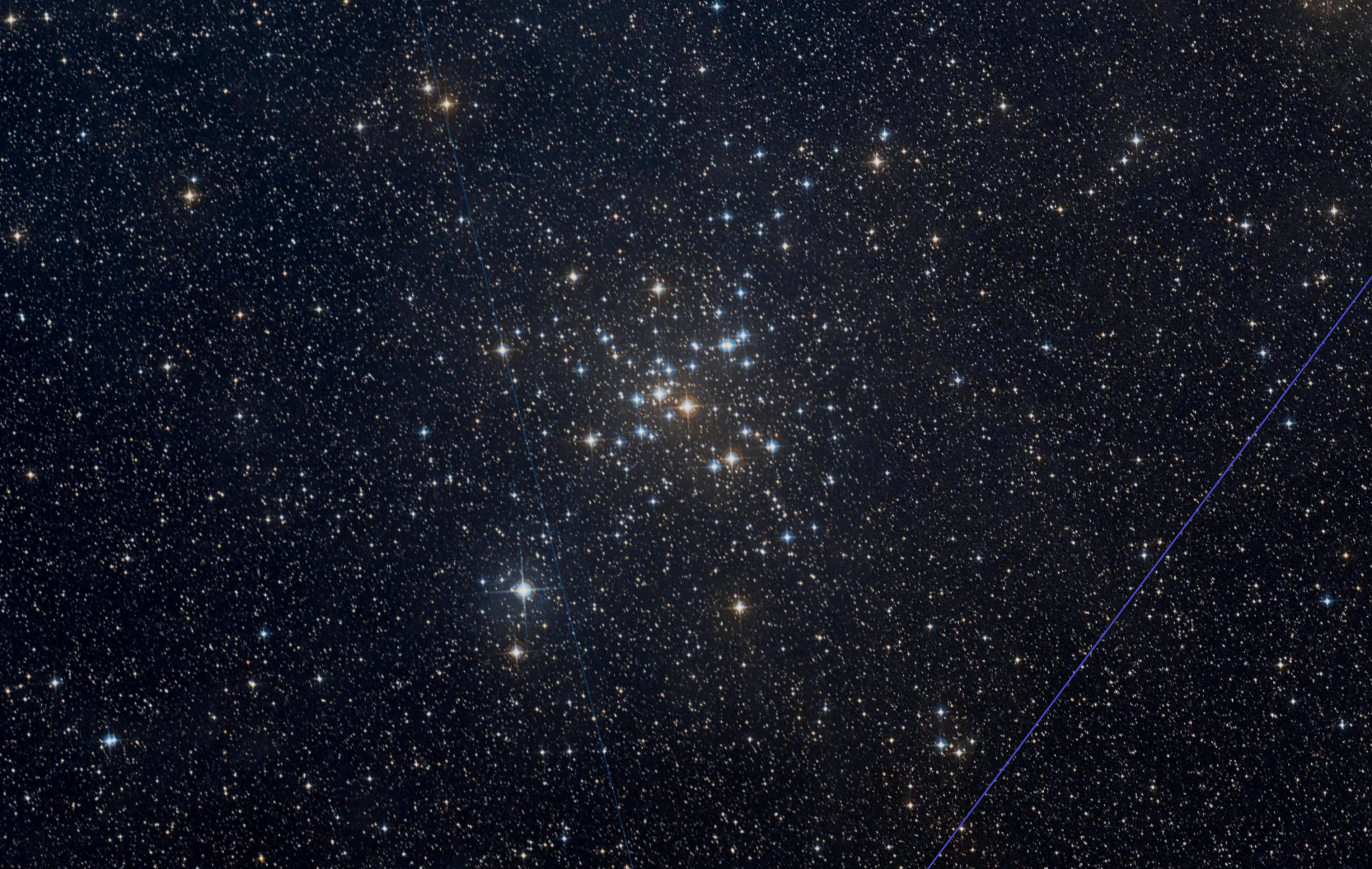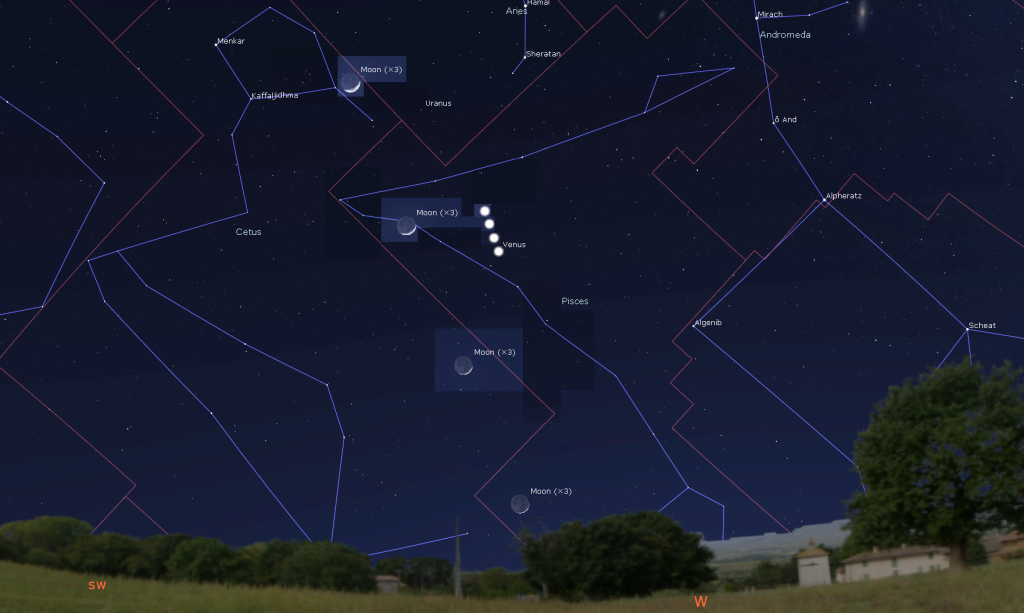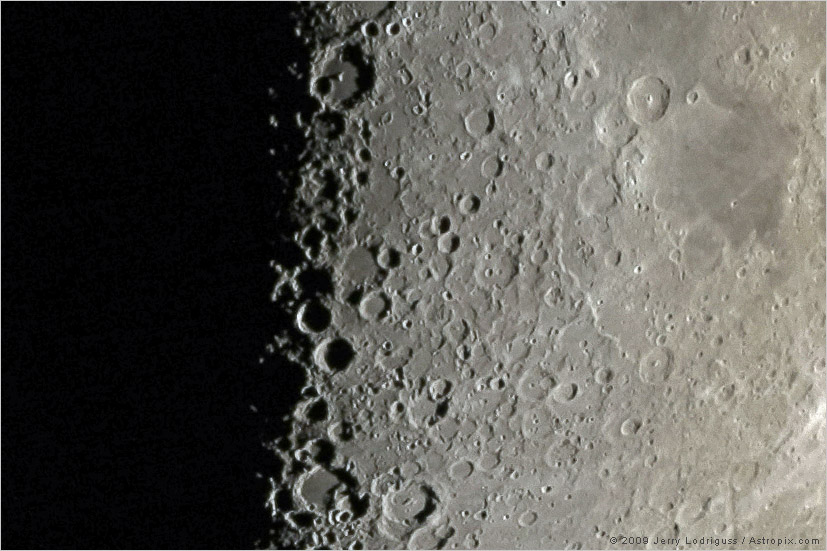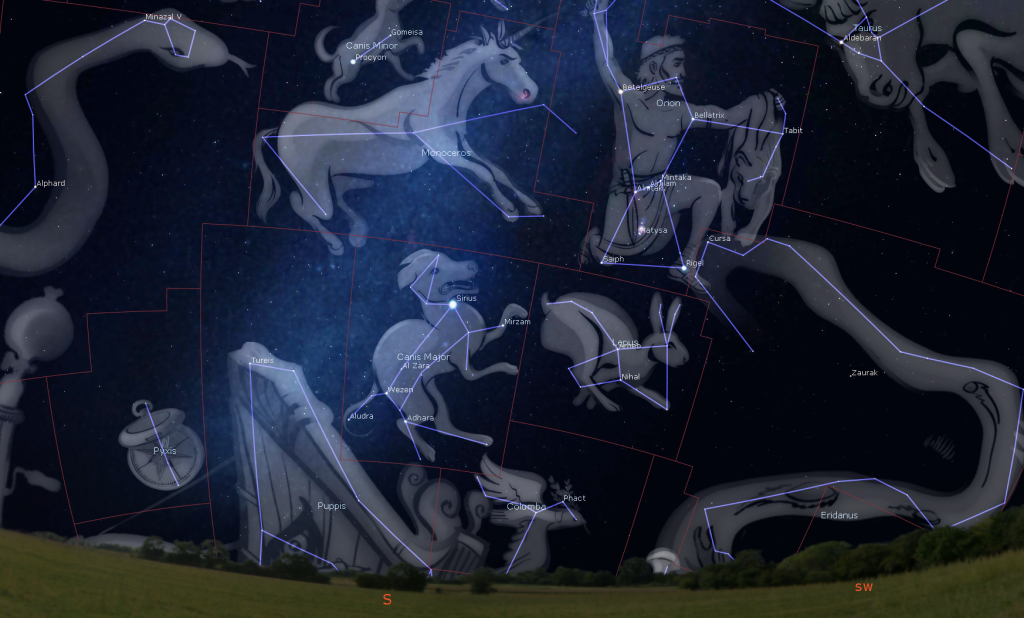A Lengthy Lunar Month Includes the Moon Meeting Venus and a Lunar X, Pre-Dawn Planets Align, and We Walk the Dog!

A close-up view of Messier 41, also known as the Little Beehive Cluster, in Canis Major. The area of the sky shown here is about four finger widths below Sirius, and spans about one finger width (or 1 degree) in height – so the cluster is as large as a full moon.
Hello, Late-February Stargazers!
Here are your Astronomy Skylights for the week of February 23rd, 2020 by Chris Vaughan. Feel free to send me your comments, questions, and suggested topics. You can also follow me on Twitter as @astrogeoguy! Unless otherwise noted, all times are expressed in Eastern Time. To receive Skylights by email, please click this MailChimp link.
I can bring my Digital Starlab portable inflatable planetarium to your school or other daytime or evening event. Contact me through AstroGeo.ca, and we’ll tour the Universe together!
The moon will return to evening skies the world over in spectacular fashion when it shares the sky with Venus, the Goddess of Love in the western sky after sunset for much of this week. It’s also a great time to view the waxing moon in binoculars and telescopes, including the Lunar X. I walk you through the evening constellation of Canis Major (the Big Dog), and its treats. Meanwhile, early risers can enjoy the planetary parade of Mars, Jupiter, and Saturn in the pre-dawn southeast. Here are your Skylights!
The Moon and a Lunar X
The moon reached its new moon phase this morning (Sunday). Your first opportunity to see the moon again will come after sunset on Monday evening. Once the sun is completely gone, at about 6 pm in your local time zone, observers around the world should scan the sky about a fist’s diameter above the west-southwestern horizon for the extremely thin crescent moon. The moon will be less than 2% illuminated – that’s about as thin as we ever see it!
New moons mark the start of a lunar month, and the one we’ve just begun will be the longest of 2020 – with a duration of 29 days 17 hours and 56 minutes. Lunar months can vary in length by about half a day because the moon’s orbital speed varies with its distance from the Earth – one of Johannes Kepler’s three laws of orbital motion. When the moon is near perigee (closest to Earth) it travels faster. When the moon is near apogee (farthest from Earth) it travels much more slowly. The February and March new moon phases both happen near apogee – so the lunar month falling between them will get a “double helping of slowness” – making it longer than average. This year’s shortest lunar month will occur in August. It will be nearly ten hours shorter than March’s. By the way – if a new moon is happening at apogee, then the corresponding full moon two weeks later must be happening near perigee. That’s why March will have the biggest Supermoon of 2020.
For the rest of this week, the moon will grow in illuminated phase while it hops higher in the sky. By Tuesday, the moon will shine prettily in a darkening sky for a while before setting. The evenings from Tuesday through Friday will offer fantastic views and photographs of the crescent moon near Venus, especially on Thursday, when the moon and Venus will be side by side and a palm’s width apart.

The next two weeks are also the best times to view the moon in your binoculars or backyard telescopes. The moon will already be up in the sky at sunset, so it will be conveniently positioned in the evening sky for youngsters with early bed times, and the sunlight striking the moon will be arriving at a shallow angle – nearly horizontally along the pole-to-pole terminator line that separates the lit and dark hemispheres – so the topography on the moon will be thrown into stark relief. The moon has no atmosphere to scatter light – so the shadows on it are extra dark. The Illumination changes every night – and even hour by hour – so take every opportunity to enjoy our beautiful natural satellite.
For the end of the week, the moon will traverse the modest stars of the constellations Cetus (the Whale / Sea-Monster) and then enter Taurus (the Bull). On Sunday night, look for the bright star Aldebaran sitting a generous palm’s width to the upper left of the nearly half-illuminated moon. That star marks the southern eye of the bull. The bright little star cluster known as the Pleiades, and Messier 45, and Subaru (in Japan), will be positioned about the same distance to the moon’s right. It’s spectacular in binoculars – even when the bright moon is nearby!

Several times a year, for a few hours near its first quarter phase, a feature on the moon called the Lunar X becomes visible in strong binoculars and backyard telescopes. When the rims of the craters Parbach, la Caille, and Blanchinus are illuminated from a particular angle of sunlight, they form a small, but very obvious X-shape. The phenomenon called is pareidolia – the tendency of the human mind to see familiar objects when looking at random patterns. The Lunar X is located near the terminator, about one third of the way up from the southern pole of the Moon (at 2° East, 24° South). The prominent round crater Werner sits to its lower right. On Sunday, March 1, the Lunar X is predicted to peak in intensity at 6:52 pm EST (or 23:52 GMT) – but the phenomenon will be visible for approximately two hours on either side of that time. This event should be visible wherever the moon is shining in a dark sky during that time window. Simply adjust for your difference from the Eastern Time zone. For the GTA, the Moon will be positioned in the southwestern evening sky.
The Planets
Whether or not the moon is passing by, Venus will gleam in the western evening sky for several more months. I had my telescope out on Friday night, and Venus was almost bright enough to cast a shadow! And it’s still brightening. It won’t reach maximum brightness until early May! This week, Venus will set in the west by about 10 pm local time. If you want to see Venus’ less-than-fully-illuminated disk in your telescope, as I did on Friday, try to view it as early as you can spot it. In a twilit sky, its brightness won’t hide its shape as much. And, when Venus is higher in the sky you’ll be viewing the planet through less of Earth’s distorting atmosphere.
The distant ice giant planet Uranus can be seen for a few hours after dusk, too. This week’s waxing moon won’t help matters – especially when the moon sits to the left of Uranus on Friday evening. Shining at magnitude 5.8, Uranus is bright enough to see under dark sky conditions with unaided eyes and with binoculars – or through small telescopes under less-dark conditions. This week, the blue-green planet will set at about 11 pm local time. I recommend that you view it while it’s higher, too – but after the sky has darkened. Uranus is located a generous fist’s width to the upper left (or 13° to the celestial east) of Venus. To help you find it, I posted a recent, detailed star chart here.

The real spectacle continues to be happening in the southeastern pre-dawn sky, where the three bright planets Mars, Jupiter, and Saturn are nicely lined up along the ecliptic. They are very easy to see with your unaided eyes – if you have an open view to the southeast. Reddish Mars will be rising first, at about 4 am in your local time zone. Over the next few weeks, Mars’ faster orbital motion will carry it past Jupiter, and then Saturn. Stay tuned for when!
Mars is now traversing the constellation of Sagittarius (the Archer) and the Milky Way. On Saturday, February 29, and on the following morning, the orbital motion of Mars will carry it very close to the bright globular star cluster named Messier 22. At closest approach on February 29, both objects will appear together in the eyepiece of a backyard telescope at medium magnification until morning twilight arrives. The globular cluster will appear as a fuzzy grey patch to the lower right of Mars in binoculars, too.
Much brighter and whiter Jupiter will sit about a fist’s diameter to Mars’ lower left (or 10° to the celestial east). Jupiter will be rising at about 4:45 am, and should be easily visible until sunrise. The Great Red Spot will be visible on Jupiter on Sunday morning, March 1.

Last in the chain – for the moment – Yellow-tinted Saturn will be sitting less than a palm’s width to Jupiter’s lower left (or another 9° east). It’s not as bright, so it will disappear before the sun rises. Late this week, swift Mercury will pop out from the sun’s glare and begin to swing towards Saturn. The innermost planet will easier to spot next week, though.
Let’s Walk the Dog
The night sky’s brightest star Sirius is sure to catch your eye in the evening sky this time of the year. Once the sky darkens after 7:30 pm local time, Sirius will be sitting less than a third of the way up the southern sky, to the lower left of Orion (the Hunter). Sirius will reach its highest position over the southern horizon at 9 pm and then descend into the southwestern sky and set just before 2 am local time.
Sirius name means “searing” or “scorching” in Greek. It’s also commonly known as the Dog Star because it is the brightest star in the constellation Canis Major (the Big Dog). To my eyes, the constellation genuinely resembles a wiener dog! Sirius sparkles at the dog’s collar. The pup’s head is formed by several medium-bright stars to Sirius’ upper left, but those are near the limit of visibility in urban skies. Nose to tail, the constellation measures about 19°, or two fist diameters; and ears to paws spans about one fist diameter. The rest of the dog’s body, composed of more easily visible stars, extends to the lower left (southeast) of Sirius. The dog is rearing up and facing west, as if he is begging Orion for a treat.

About a fist’s diameter below Sirius is the bright star Wezen, which marks the dog’s “bottom”. Wezen, Arabic for “weight” is a rare, massive, yellow supergiant star. One day it will explode in a supernova. The tip of the dog’s tail, marked by a modest star named Aludra, is found 4° (four finger widths) to the lower left of Wezen. Four degrees to the lower right of Wezen, a bright star named Adhara represents the dog’s rear legs. (Some representations include two dimmer stars for the rear paws.) Adhara is a hot blue giant star with a surface temperature of a whopping 21,000 K and located about 34 light-years from the sun. It’s the brightest star in the sky when viewed in ultraviolet light, and it, too, is on the way to death by supernova.
The dog’s front legs are formed by the bright star Mirzam, which is located about a palm’s width to the lower right of Sirius. Mirzam, which means “the Herald” because it rises just before Sirius, is 60 times more luminous than Sirius. If that star were located where Sirius is, instead of 500 light-years away from us, it would appear 15 times brighter than Venus!

In the heart of Canis Major, about four finger widths below Sirius, is a bright little cluster of stars designated Messier 41, sometimes called the Little Beehive Cluster. Binoculars should show it easily. The cluster, which is about 2300 light-years away from us, consists of several brighter golden stars and numerous fainter ones. Another nice cluster sits about 2.5 finger widths to the upper left of Wezen. Scan around that area of sky with your binoculars – the winter Milky Way has populated Canis Major with many such dog treats.
Canis Major is only one of Orion’s two hunting companions. The other dog, Canis Minor (the Smaller Dog), sits 30° (or three fist diameters) to Orion’s left. Canis Minor is composed of only two stars – very bright white Procyon and dimmer Gomeisa, which sits about four finger widths to Procyon’s upper right. Ironically, the constellation resembles a stick more than a dog! The two dogs might well be hunting Lepus (the Rabbit), a constellation of modest stars located directly below Orion.
Sirius is so bright because it is about 25 times more luminous than our Sun, and is only a mere 8.6 light-years away from Earth. Furthermore, it is heading towards us, and will brighten over the next millennia! Sirius has a tiny companion – a white dwarf star designated Sirius B, that some astronomers call the Pup. I prefer to call it the Flea!
Sirius is famous for exhibiting flashes of intense colour as it twinkles. This is because northern hemisphere observers usually see the star positioned low in the sky, so its very bright starlight is passing through a thicker blanket of air. The pockets of turbulence in our atmosphere that makes stars twinkle also work like tiny refracting prisms – splitting apart Sirius’ white starlight and randomly sending different colours (wavelengths) to our eyes.

The ancient Egyptians linked their calendar to the arrival of Sirius in the pre-dawn sky because it signaled the onset of the Nile floods around the beginning of summer. That phenomenon also gave us the expression “Dog Days of Summer”. In China, Sirius is called Tiān Láng天狼, aka “the Celestial Wolf”. Many First Nations cultures saw a dog’s shape in these stars and called Sirius the Moon Dog Star (Inuit), the Wolf Star (Pawnee), and the Coyote Star. On the next clear evening, have a look at our bright neighbour!
Follow the Winter Milky Way
If you missed last week’s tour of the winter Milky Way, I posted it here.
Public Astro-Themed Events
Taking advantage of dark, moonless evening skies this week, astronomers with the RASC Toronto Centre will gather for dark sky stargazing at Long Sault Conservation Area, northeast of Oshawa on (only) the first clear evening (Monday, Tuesday, or Thursday) this week. You don’t need to be a RASC member, or own any equipment, to join them. Check here for details and watch the banner on their homepage or their Facebook page for the GO or NO-GO decision around 5 pm each day.
Every Monday evening, York University’s Allan I. Carswell Observatory runs an online star party – broadcasting views from four telescopes/cameras, answering viewer questions, and taking requests! Details are here. On Wednesday nights they offer free public viewing through their rooftop telescopes, including their brand new 1-metre telescope! If it’s cloudy, the astronomers give tours and presentations. Registration and details are here.
At 7:30 pm on Wednesday, February 26, the RASC Toronto Centre will hold their free monthly Recreational Astronomy Night Meeting at the Ontario Science Centre, and the public are welcome. Talks include The Sky This Month, Johannes Kepler, and the Giant Magellan Telescope. These meetings are also streamed live on RASC-TC’s YouTube channel. Check here for details. Parking is free.
On Wednesday, February 26 at 6 pm at Ben McNally Books, 366 Bay St, Toronto, author and frequent guest of CBC’s Quirks and Quarks, Amy Shira Teitel will discuss and sign her new book Fighting for Space, the story of two pioneering women who tried to become the first female astronauts in the Mercury program. This is a free event. Details and Eventbrite registration is here.
On Thursday, February 27 at 6 pm at York University, renowned astrophysicist and science communicator Dr. Katie Mack will present a free public talk entitled The Death of a Universe. This is a free event. Details and Eventbrite registration is here.
On Friday, February 28 at 6:30 pm at J.R.R. Macleod Auditorium at U of T, the Astronomy and Space Exploration Society (ASX) at U of T will present their annual symposium, this year featuring Dr. Catherine Asaro, Dr. John G. Cramer, and Dr. Geoffrey A. Landis — scientists and science fictions writers all — on a fantastical odyssey through wormholes and to the very frontiers of extraplanetary colonisation. Details and Eventbrite registration is here.
On Saturday, February 29 at 3 pm at The Gorilla Store, 609 College St., Toronto, Join “professional Martian” Dr. Tanya Harrison and “geographer of space” Dr. Danny Bednar as they discuss the ongoing impacts of the Moon landing on human imagination, ambition, and achievement, moderated by Dr. Sara Mazrouei. This is a free event. Details are here.
Keep looking up, and enjoy the sky when you do. I love questions and requests. Send me some!